Related Research Articles
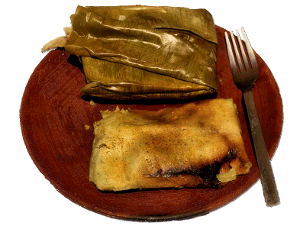
A tamale, in Spanish tamal, is a traditional Mesoamerican dish made of masa, a dough made from nixtamalized corn, which is steamed in a corn husk or banana leaves. The wrapping can either be discarded prior to eating or used as a plate. Tamales can be filled with meats, cheeses, fruits, vegetables, herbs, chilies, or any preparation according to taste, and both the filling and the cooking liquid may be seasoned.

The Nebraska Cornhuskers are the intercollegiate athletic teams that represent the University of Nebraska–Lincoln. The university is a member of the Big Ten Conference and competes in NCAA Division I, fielding twenty-two varsity teams in fifteen sports. Nineteen of these teams participate in the Big Ten, while rifle is a member of the single-sport Patriot Rifle Conference and beach volleyball and bowling compete as independents. The Cornhuskers have two official mascots, Herbie Husker and Lil' Red.

Cornmeal is a meal ground from dried corn (maize). It is a common staple food, and is ground to coarse, medium, and fine consistencies, but not as fine as wheat flour can be. In Mexico, very finely ground cornmeal is referred to as corn flour. When fine cornmeal is made from maize that has been soaked in an alkaline solution, e.g., limewater, it is called masa harina, which is used for making arepas, tamales and tortillas. Boiled cornmeal is called polenta in Italy and is also a traditional dish and bread substitute in Romania.
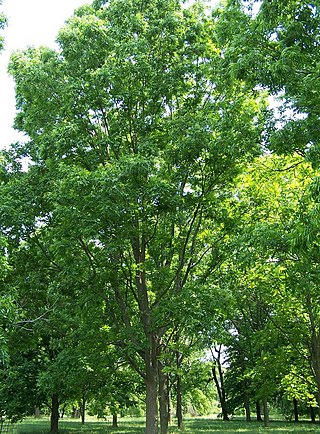
The pecan is a species of hickory native to the southern United States and northern Mexico in the region of the Mississippi River.

Herbie Husker is the oldest current mascot of the Nebraska Cornhuskers. Herbie was created by Lubbock-based artist Dirk West and first appeared on the cover of the Huskers' media guide in 1974. Soon after, he became the university's official mascot. Herbie frequently travels to academic and athletic events at the University of Nebraska–Lincoln, and often appears at events throughout Lincoln.

Juglans nigra, the eastern American black walnut, is a species of deciduous tree in the walnut family, Juglandaceae, native to North America. It grows mostly in riparian zones, from southern Ontario, west to southeast South Dakota, south to Georgia, northern Florida and southwest to central Texas. Wild trees in the upper Ottawa Valley may be an isolated native population or may have derived from planted trees.

Threshing, or thrashing, is the process of loosening the edible part of grain from the straw to which it is attached. It is the step in grain preparation after reaping. Threshing does not remove the bran from the grain.

Corn on the cob is a culinary term for a cooked ear of sweet corn (maize) eaten directly off the cob. The ear is picked while the endosperm is in the "milk stage" so that the kernels are still tender. Ears of corn are steamed, boiled, or grilled usually without their green husks, or roasted with them. The husk leaves are removed before serving.
Corn construction refers to the use of corn (maize) in construction. The tassel, leaf, silk, cob in husks, and the stalk are the parts of corn. According to the Michigan Department of Agriculture, "corn can be made into fuel, abrasives, solvents, charcoal, animal feed, bedding for animals, insulation, adhesives, and more. The kernel is used as oil, bran, starch, glutamates, animal feed, and solvents. The silk is combined with other parts of the corn plant to be used as part of animal feed, silage, and fuels. Husks are made into dolls and used as filling materials. The stalk is used to make paper, wallboard, silage, syrup, and rayon ."

The Nebraska Cornhuskers football team competes as part of the NCAA Division I Football Bowl Subdivision, representing the University of Nebraska–Lincoln in the West Division of the Big Ten. Nebraska plays its home games at Memorial Stadium, where it has sold out every game since 1962.

The Advance-Rumely Company of La Porte, Indiana was an American pioneering producer of many types of agricultural machinery, most notably threshing machines and large tractors. Started in 1853 manufacturing threshers and later moved on to steam engines. Allis-Chalmers Manufacturing Co. purchased Advance-Rumley in 1931. The company's main works would become what was later known as the "La Porte plant".

Sorghum bicolor, commonly called sorghum and also known as great millet, broomcorn, guinea corn, durra, imphee, jowar, or milo, is a grass species cultivated for its grain, which is used for food for humans, animal feed, and ethanol production. Sorghum originated in Africa, and is now cultivated widely in tropical and subtropical regions. Sorghum is the world's fifth-most important cereal crop after rice, wheat, maize, and barley, with 61,000,000 metric tons of annual global production in 2021. S. bicolor is typically an annual, but some cultivars are perennial. It grows in clumps that may reach over 4 metres (13 ft) high. The grain is small, ranging from 2 to 4 millimetres in diameter. Sweet sorghums are sorghum cultivars that are primarily grown for forage, syrup production, and ethanol; they are taller than those grown for grain.

Intensive crop farming is a modern industrialized form of crop farming. Intensive crop farming's methods include innovation in agricultural machinery, farming methods, genetic engineering technology, techniques for achieving economies of scale in production, the creation of new markets for consumption, patent protection of genetic information, and global trade. These methods are widespread in developed nations.

Maize, also known as corn in North American and Australian English, is a cereal grain first domesticated by indigenous peoples in southern Mexico about 10,000 years ago. The leafy stalk of the plant gives rise to inflorescences which produce pollen and separate ovuliferous inflorescences called ears that when fertilized yield kernels or seeds, which are botanical fruits. The term maize is preferred in formal, scientific, and international usage as the common name because it refers specifically to this one grain whereas corn refers to any principal cereal crop cultivated in a country. For example, in North America and Australia corn is often used for maize, but in England and Wales it can refer to wheat or barley, and in Scotland and Ireland to oats.
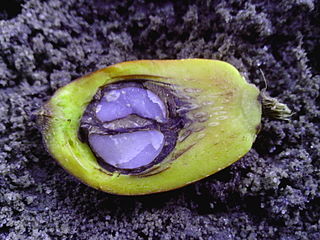
The palm kernel is the edible seed of the oil palm fruit. The fruit yields two distinct oils: palm oil derived from the outer parts of the fruit, and palm kernel oil derived from the kernel.

Purple corn or purple maize is group of flint maize varieties originating in South America, descended from a common ancestral variety termed "kʼculli" in Quechua. It is most commonly grown in the Andes of Peru, Bolivia and Ecuador.
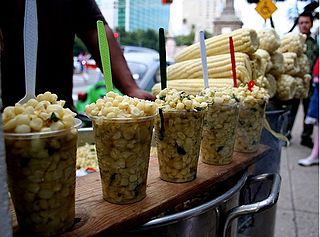
Esquites also known as elote en vaso, also served in the Southwestern USA is a Mexican snack or antojito. One can find them at local markets, and street vendors selling corn. The word esquites comes from the Nahuatl word ízquitl, which means "toasted corn".

A corn husk doll is a Native American doll made out of the dried leaves or "husk" of a corn cob. Maize, known in some countries as corn, is a large grain plant domesticated by indigenous peoples in Mesoamerica in prehistoric times. Every part of the ear of corn was used. Women braided the husks for rope and twine and coiled them into containers and mats. Shredded husks made good kindling and filling for pillows and mattresses. The corncobs served as bottle stoppers, scrubbing brushes, and fuel for smoking meat. Corn silk made hair for corn husk dolls. Corn husk dolls have been made by Northeastern Native Americans probably since the beginnings of corn agriculture more than a thousand years ago. Brittle dried cornhusks become soft if soaked in water and produce finished dolls sturdy enough for children's toys. Making corn husk dolls was adopted by early European settlers in the United States of America. Corn husk doll making is now practiced in the United States as a link to Native American culture and the arts and crafts of the settlers.. In other cultures, corn dollies are used to celebrate Lammas. Corn dollies are magical charms thought to protect the home, livestock, and personal wellness of the maker and their family. They may be a home for the spirit of the crop. The tradition pertains to the idea that the crop of grain has a spirit that loses its home after the final harvest and it is therefore to be invited and housed in the home over the winter before being returned to the earth in spring for the next crop.
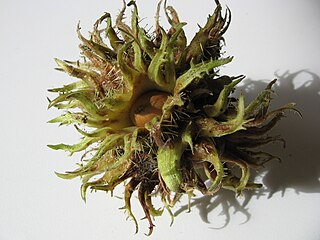
Husk in botany is the outer shell or coating of a seed. In the United States, the term husk often refers to the leafy outer covering of an ear of maize (corn) as it grows on the plant. Literally, a husk or hull includes the protective outer covering of a seed, fruit, or vegetable.
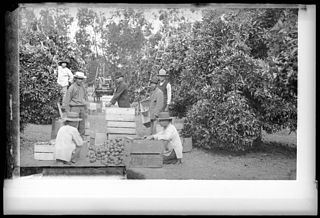
The Citrus Strike of 1936 was a strike in southern California among citrus workers for better working conditions that took place within various cities within Orange County, such as Fullerton and Anaheim from June 10 to July 25. There were multiple factors that led the citrus workers to strike including their paid wages, working conditions, living conditions, and overall social dynamics. The strike itself was significant for ending the myth of "contented Mexican labor." It was one of the most violently suppressed strikes of the early 20th century in the United States. The sheriff who suppressed the largely Mexican 3,000 citrus pickers was himself a citrus rancher who issued a "shoot to kill" order on the strikers. The aftermath of the strike effort led to 400 citrus workers being arrested in total, while others were forced to either face jail time or possible deportation back to Mexico. It has also been referred to as the Citrus War and the Citrus Riots.
References
- ↑ "Agricultural Mechanization - History part 3 - Greatest Engineering Achievements of the Twentieth Century". www.greatachievements.org. Retrieved 2022-05-10.
- ↑ "Corn Picker and Husker, 1928 - The Henry Ford". www.thehenryford.org. Retrieved 2022-05-10.